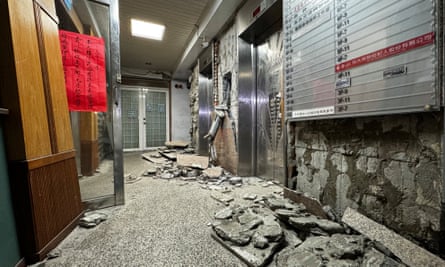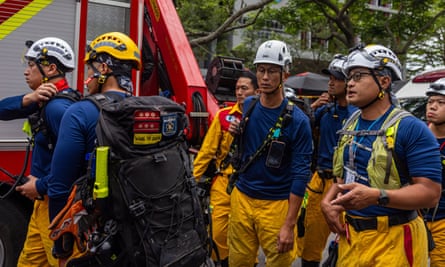For Nina Huang, it was the shaking that jolted her awake. “The first thing I did when I woke up was to hold the cupboard next to my daughter. I was afraid that it might fall down on her,” she recalled. Then her phone buzzed with a warning about a tsunami.
The biggest fear for Huang and her husband was that the bridge connecting their waterfront village of Yanliao to the city of Hualien would collapse, leaving them stranded.
So they drove to the city with their one-year-old daughter and waited in a car park for the tremors to stop, away from any buildings that might collapse on them.
But the bridge did not collapse. And despite the fact that the 7.4 magnitude earthquake, which struck along the east coast shortly before 8am on Wednesday, was Taiwan’s biggest in 25 years, relatively few people died or were injured. In 2016, a smaller quake claimed more than 100 lives.
While last week’s earthquake killed at least 12 people, Hualien county, which has a population of more than 300,000, fared remarkably well in the face of dramatic tremors.

Taiwan has learned to react quickly to emergencies because of the omnipresent threats of natural or human-made disasters. The island and its surrounding islets sit near the intersection of three tectonic plates in the world’s most seismically active region, known as the “ring of fire”.
The threat of an attack from China, which frequently conducts military drills near Taiwan, also puts people on high alert. Huang had already scouted out her nearest bunker – a nearby police station – after a nationwide alert about a Chinese satellite launch in January.
Taiwan “has done a lot to improve earthquake resilience since the magnitude 7.7 Chi-Chi earthquake in 1999”, said Adam Pascale, chief scientist at the Seismology Research Centre in Victoria, Australia, referring to a quake that killed nearly 2,500 people. “They introduced new building standards, reinforced existing buildings and established an earthquake early warning system. Sensors throughout the country can potentially provide precious seconds of warning of incoming strong shaking so that people have time to take cover to protect themselves from falling objects.”
The Chi-Chi earthquake was a wake-up call for Taiwan’s policymakers. A museum near the epicentre preserves the ruins of a collapsed junior high school as a testament to the dangers of poorly reinforced buildings. The date of the 1999 quake, 21 September, is now a designated day for nationwide disaster drills, with mock alerts sent to people’s phones and practice evacuations.
Pascale said that public education and important preparedness policies such as updating building safety standards were things that “often only get short-term attention in other parts of the world following a disaster”. But the decades of improvements made since Chi-Chi meant that Taiwan was “as well prepared for this earthquake as it could be”.
Taiwan’s preparedness comes in the form of better buildings, early warning systems, education campaigns and well-honed rescue operations.
After 1999, the authorities updated building standards to make new structures more quake-resistant. But with more than 4 million homes in building that are at least 30 years old, according to official statistics, the government has also introduced subsidies for local authorities to inspect and upgrade any buildings that do not meet modern safety standards.
Individuals can also apply for subsidies of up to 4.5m new Taiwan dollars (£110,000) to upgrade buildings, by, for example, reinforcing floors and concrete walls.
The nationwide mobile alerts also give people what experts say are precious seconds to find cover before debris starts to tumble. CCTV footage from a maternity centre in Taipei, the capital, which also felt some shocks, showed nurses racing to stabilise wobbling cots to protect the newborns.
In another video, the earthquake warning system can be seen interrupting a live television broadcast more than 10 seconds before the studio starts to shake (although the presenter continues to report).

Still, people in some counties that experienced smaller quakes complained that they did not receive phone alerts. Taiwan’s Central Weather Administration said they were only sent to people in areas which registered an intensity of 4 or above , although the agency is reportedly working on developing an artificial intelligence system to provide more targeted warnings in future.
Pascale noted that setting notification thresholds was a difficult balance. “It often takes an event like this to highlight the difference between a calculated threshold and what the community expects to hear about,” he said, adding that the danger of making alert systems too sensitive is that “people ignore or disable notifications altogether”.
Taiwan’s rescue operations are far from over, with aftershocks and landslides expected over the weekend, complicating efforts to save the hundreds of people who are still trapped. But for a small island facing multiple existential threats, Taiwan may take comfort in last week’s response.
